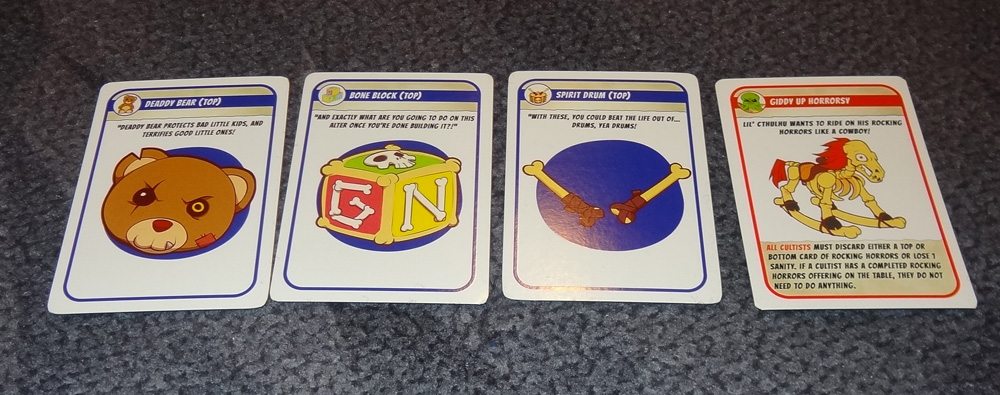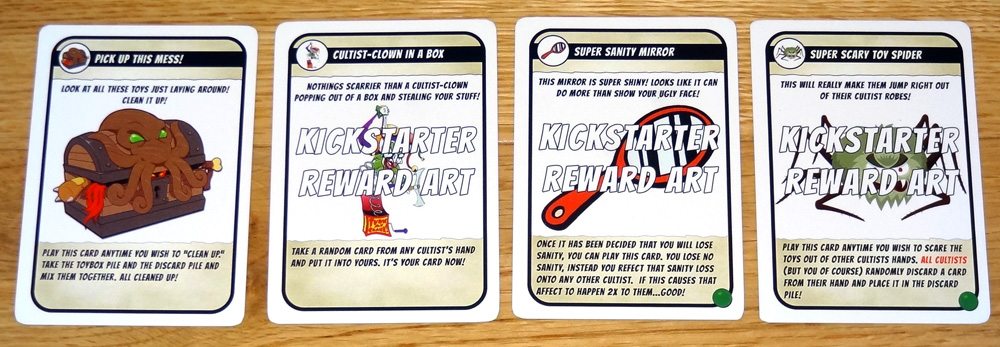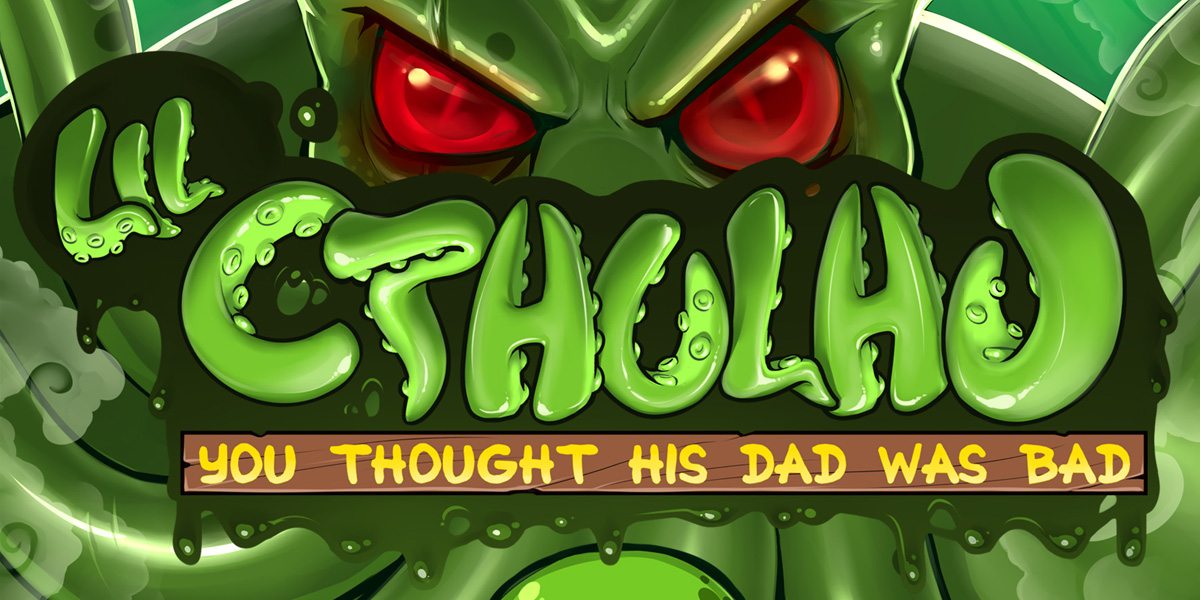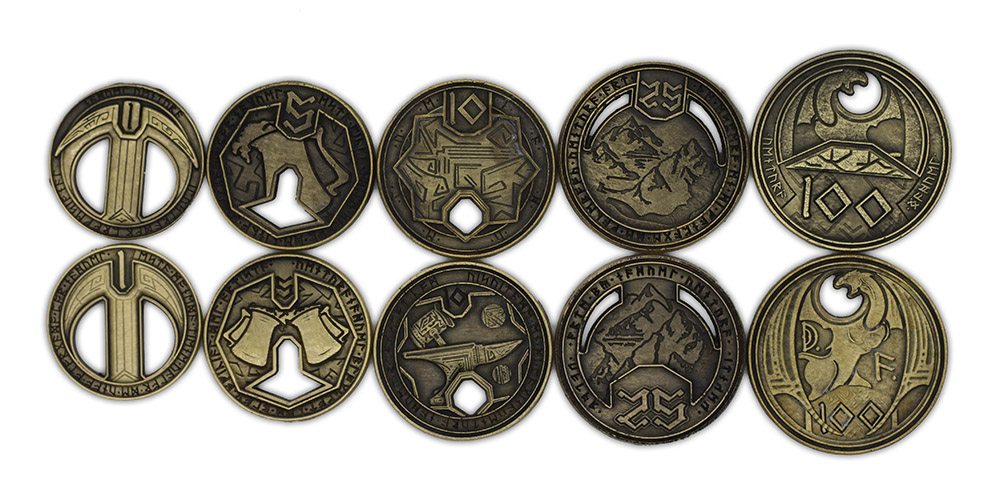Cultists of Cthulhu are commanded to do some pretty terrible jobs, but this is the worst: babysitting Li’l Cthulhu. His tantrums will sap your sanity unless you bring an offering of his favorite toys … which are scattered in pieces in his infernal toybox.
At a glance: Li’l Cthulhu is a press-your-luck game for 2 to 5 players, ages 6 and up, and takes about 30 minutes to play. It is currently seeking funding on Kickstarter, with a $25 pledge for a copy of the game (or $30 for the game plus a bonus expansion). Note to parents: although the game is about Lovecraftian horrors, it’s all done in a funny, cute way, so there’s nothing too terrifying for younger players. Except Li’l Cthulhu’s diaper. I don’t even want to think about that.
New to Kickstarter? Check out our crowdfunding primer.

Components
Note: the final components list may change slightly but this is currently what’s in the prototype:
- 120 Toybox cards:
- 60 Purple Toy Part cards
- 30 Black Dark Toy cards
- 30 Red Tantrum cards
- 6 Demand cards
- 80 Sanity tokens
The cards all have cute illustrations of creepy things, like the “Death Rattle” (a skull on a bone handle) or the Necronomicoloring Book. The Toy Parts cards each show one half of one of Li’l Cthulhu’s favorite toys. The Dark Toy cards all have special abilities printed on them, and for the most part they’re pretty easy to interpret.
The Sanity tokens in my review prototype were cardboard tokens, but I don’t know what the final product will be. It’s funny that you get so many of them, because even in a 5 player game, it’s unlikely you’ll ever have that much sanity collectively…
How to play
The game provides rules for several different complexity levels, so you can tune the game to make it easier or harder, depending on whether you’re playing with younger kids or really cutthroat adults or something in between. I’ll explain the standard rules, and then explain the other variations briefly.
The goal of the game is to collect and assemble all 3 toys that Li’l Cthulhu is demanding, or be the last Cultist with sanity remaining.

To set up, you shuffle the 6 Demand cards and deal 3 face-up on the table. These are the toys that Li’l Cthulhu wants. (The other cards are set aside.) Give every player 13 Sanity tokens, with the rest in a supply. Finally, shuffle the Toybox cards and place the deck in the center.
On your turn, you must do at least one of these two actions: Draw a card from the Toybox, or complete an offering to Li’l Cthulhu. (You may do both actions if you choose.)

Draw a card: Draw the top card of the Toybox and display it on the table. If it’s a toy, you pay 1 Sanity to the supply (the toybox is a horrific place). You may then continue to draw cards at no additional Sanity cost until you choose to stop or you draw a Tantrum card.
If you stop, you take all the toy cards you’ve drawn and put them in your hand. If you draw a Tantrum card, however, the toy cards drawn this turn are discarded, and you resolve the Tantrum card, and then your turn is over.
Tantrum cards usually affect everyone, although there are some in which you get a choice to take it or share it, which will have different effects. A Tantrum might force players to discard cards or Sanity or pass cards to the left–you never know what Li’l Cthulhu has in store. (Note: if your first draw is a Tantrum card, you don’t pay the 1 Sanity for reaching into the toybox, but you still must resolve the Tantrum.)

Complete an offering: If you have toy parts that go together, you may assemble any number of completed toys on your turn to offer to Li’l Cthulhu. If it’s a toy that he is not demanding, he is pacified: you discard the toy parts and regain 2 Sanity. If it’s one of the toys that he’s demanding, he is satisfied: you put the toy parts on the table in front of you, regain 3 Sanity, and may optionally draw 1 free card from the Toybox. This free draw won’t cost you the usual 1 Sanity, but if it’s a Tantrum you’ll still have to deal with it.
Finally, at the end of your turn, you must discard down to 5 cards.
If you assemble all 3 toys that Li’l Cthulhu wants, you win the game! Or, if you’re the last player left with Sanity, you win. (If nobody has Sanity at the end of a turn, then you have all succumbed to Li’l Cthulhu and nobody wins. Also, Cthulhu will probably fire you as babysitters.)
Variants
You can easily shorten or lengthen the game by adjusting the number of Demand cards at the beginning of the game.
There’s a variant that removes the press-your-luck element, making it only a set-collection game. In this case, everyone starts with 3 Toybox cards (not Tantrums). In this one, you may draw either from the Toybox deck or the Toybox discard pile. When you take from the Toybox, you are guaranteed to get exactly 1 toy and pay 1 Sanity for it, because if you draw a Tantrum you resolve it and then keep going until you’ve gotten a toy. You may also draw from the discard pile instead–the first card does not cost you Sanity, but you may also take the second and third cards in the discard pile by paying 2 and 3 Sanity, respectively. Dark Toys and Tantrums are placed in a separate “Used” pile after they’ve been used or resolved, so they can’t be drawn back out of the discard pile.
Other variations involve removing Tantrum cards or Dark Toy cards as well, so that makes it even easier for younger kids–no Sanity to deal with, just collecting toy parts.

The Verdict
Li’l Cthulhu is a quick, funny game that (so far in my experience) is more likely to end because everyone goes insane than because somebody actually managed to find and assemble all three toys. It’s easy to teach, even with the full press-your-luck rules, and I think most people probably won’t need to use the simplified variants, although it’s nice to have them there. For instance, I actually played this with my toddler with the full rules. She couldn’t read the cards, of course, and doesn’t really have any real grasp of probabilities, but she could recognize the toy parts and knew that red cards were bad. She kept drawing cards even when I advised her to stop–and then won because we kept drawing Tantrums far more often than she did.
There’s a lot of chance in the game, of course, and sometimes you might not really get a choice. For instance, since you could draw a Tantrum for your first card, you might bust before even getting a choice at all–particularly since you can’t decide not to draw at all unless you have parts ready to make an Offering. (And if you haven’t been successfully collecting parts, then you can’t make an Offering.) There is an optional rule in the works that if you draw a Tantrum for your first card, you get a choice whether to keep going after resolving it–that would add a little more choice, at least.

On the other hand, an interesting aspect is that when you draw a Tantrum, it quite often affects everyone, not just you. In most press-your-luck games, you want your opponents to keep going until they bust, because then they get nothing. But in Li’l Cthulhu, a bust might even cost you more than your opponent–it just depends on the type of Tantrum drawn. I do like the variety of those, because it’s an unknown. Some just cost everyone Sanity. Some will cost you a particular toy part, or Sanity if you don’t have it. Some will cause all players to pass cards to the next player. Some force you to discard unless you pay Sanity to keep cards in your hand. So sometimes, depending on the circumstances, you may actually hope for a Tantrum on the first draw because it can cost everyone and save your standard 1 Sanity cost for a toy.
That standard cost also tends to incentivize players to keep going. Once you’ve paid your 1 Sanity for digging into the Toybox, you feel like you want to get a good deal. Why get just 1 toy when you could get 4 at the same cost, right? Of course, you should keep in mind that 25% of the cards are Tantrums.
One interesting choice that arises, though, is when to assemble your Offerings. The usual tendency is as soon as you have two pieces of a toy, you put them together and get a few Sanity back, because who knows how many Sanity or cards you’ll lose by your next turn? On the other hand, if you do save up the parts and wait, your next turn you could just make an Offering and get back some Sanity, and then avoid digging through the box at all. Sure, you won’t get any cards on that turn (except possibly a free card from making a toy that satisfies Li’l Cthulhu) but you also skip a turn paying Sanity.

The Dark Toy cards add a good bit of backstabbing and player interactions. There are cards that will protect you from losing Sanity, cards that will let you steal things from other players or dig through the discard pile, and so on. Again, there’s a good variety of those as well.
I’ve even gotten to see some of the cards that may be included if the game hits stretch goals after funding–these add even more Sanity loss and backstabbing to the game, so it’ll be a wonder if anyone survives long enough to assemble the toys.
I’ve played Li’l Cthulhu with adult gamers and my kids, and it’s a light but fun game that I think Cthulhu fans will particularly enjoy. For more information, visit the Kickstarter page.





